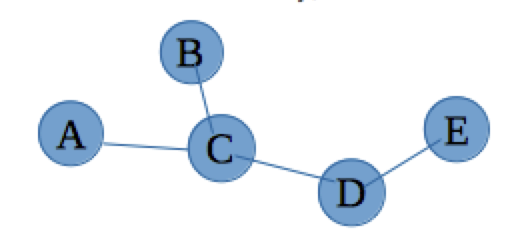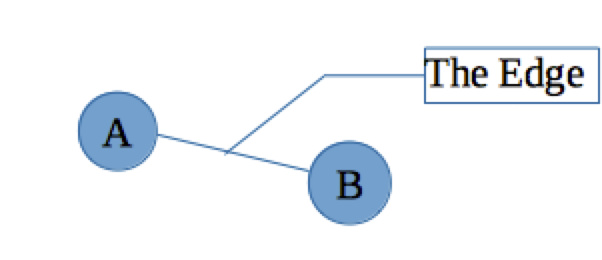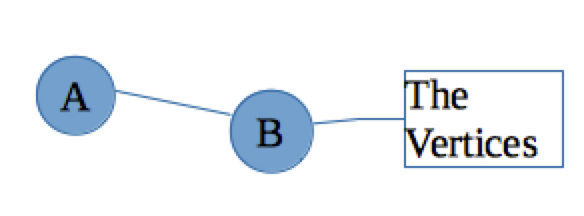-
What is a graph?
Nodes and their connections -
What is an edge?
Connects between nodes showing relationships -
What is a vertex?
Objects like a person and there information that can then compared to relationships with others -
Why would we want to use a graph database instead of a normal SQL database?
Multi Dimensional relationships
-
What is a graph?
A graph is an abstract database that contains objects (nodes or vertices) and relationships (lines or edges) between objects -
What is an edge?
Relationships between objects, comparable to foreign keys in RDBMS. -
What is a vertices?
Vertices are objects in graph (also referred as nodes) that represents an entity, which is comparable to rows in RDBMS. It contains properties of the entity, which can be anything a business or organisation wants to keep track. -
Why would we want to use a graph database instead of a normal SQL database?
When there is a large amount of relationships in the database, graph database offers higher efficiency in searches.
-
What is a graph?
An abstract data type used to model data that contains objects and some sort of relationship between the objects. -
What is an edge?
Edges are used to describe the relationships between the objects contained in the database -
What is a vertex?
A node, or vertex, is used to represent an entity object. It is like a row in a relational database. -
Why would we want to use a graph database instead of a normal SQL database?
A graph database comes in handy when there are many relationships in a data set. It can make the process of searching through this type of data much easier and efficient.
-
What is a graph?
An abstract data type typically used to model data that contains objects (referred to as nodes or vertices), and some sort of relationship between those objects (lines or edges). -
What is an edge?
Describe the relationships between the objects contained in the database, and in most they can be compared to the foreign key column of a row in a RDBMS. -
What is a vertex?
Person, Place, or Object -
Why would we want to use a graph database instead of a normal SQL database?
Offer increased efficiency for searches in some cases. The best example of this is when a business needs to perform a search that is more than one level deep.
-
What is a graph?
graph is an abstract datatype tipically model data that contains object. -
What is an edge?
graph database contain edges between each node. they are used to describe the relationships between the object in the database. -
What is a vertex?
vertex is a node , an object store information for a graph database. -
Why would we want to use a graph database instead of a normal SQL database?
when a data structure contains complex relationship between object ,we will start to consider a graph database .
-
What is a graph? A graph is an abstract data type that contains objects and relations between those objects.
-
What is an edge? Edges are relations between the objects in the database.
-
What is a vertex? An object in a graph database.
-
Why would we want to use a graph database instead of a normal SQL database? When there are a lot of relationships within a data set, or when you want to perform a search that is more than one level deep. #HODLWARRIOR
- A graph is another type of database that is composed of notes and lines that define relationships between the nodes with lines
- Edge or Line is the relationship between nodes
- Vertex is a node or entry in the database
- Graph databases are faster at pointing relationships between nodes/vertex making easier to query the database based on those relationships (edges)
What is a graph?
A graph database is a database that uses graph structure for semantic queries with nodes, edges, and properties to represent and store data. A key concept of the system is the graph (or edge or relationship ), which directly relates data items in the store. The relationships allow data in the store to be linked together directly, and in many cases retrieved with one operation.
What is an edge?
Edges , also termed graphs or relationships , are the lines that connect nodes to other nodes; they represent the relationship between them. Meaningful patterns emerge when examining the connections and interconnections of nodes, properties, and edges. Edges are the key concept in graph databases, representing an abstraction that is not directly implemented in other systems.
What is a vertex?
A vertex is an entity such as a person, place, object or relevant piece of data and edges, which represent the relationship between two nodes.
Why would we want to use a graph database instead of a normal SQL database?
- Unlike SQL databases, a graph database doesn’t utilize foreign keys or JOIN operations. Instead, all relationships are natively stored within vertices (as documents in OrientDB). This results in deep traversal capabilities, increased flexibility and enhanced agility.
- Native graph databases are equipped to easily accommodate rapidly scaling data—something particularly useful as organizations generate more and more data each day.
- Modern day applications—like recommendation engines, social media, fraud detection, forensic analysis and medical research platforms—all use graphs to process highly connected data.
- Native graph databases that apply index-free adjacency report reduced latency in create, read, update and delete (CRUD) operations.
-
What is a graph?
Graph is a relational database that uses nodes and vertices(relations) to structure the complicated relationship models in order provide a more efficient DB model than SQL -
What is an edge?
Edge is line that connects the nodes with a relation -
What is a vertex?
Vertex is the circles or nodes that can define the rows and columns -
Why would we want to use a graph database instead of a normal SQL database?
In a complicated relationship model. If deeper level relationship of an item is required, Graph offers a better structure. The queries will be returned quicker.
1. What is a graph?
It is a data type that stores information about entities (nodes) and their relationships (edges)
2. What is an edge?
Relationship between two nodes.
3. What is a vertex?
It is a node or entity in graph database.
4. Why would we want to use a graph database instead of a normal SQL database?
If dataset has a lot of relationships then data should be stored in graph db for efficiency in retrieval of that data.
Graph Databases
What is a graph?
A graph is an abstract data type that is typically used in model data that contains objects (his is referred to as nodes or vertices), and have some sort of relationship between those objects (lines or edges).

What is an edge?
Graph databases also contain edges between each node. These are use to describe the relationships between the objects contained in the database, and in most they can be compared to the foreign key column of a row in a RDBMS.

What is a vertex?
Vertices are objects such as people or products (they generally have properties).

Why would we want to use a graph database instead of a normal SQL database?
This gives the ability to directly state the relationship between two objects within a graph. A graph database provides a strong advantage over relational database systems for certain datasets. Namely, those that contain a large amount of relationships within the data.
The best example of this is when a business needs to perform a search that is more than one level deep
Ref; https://medium.com/@Kelsey.Whitehead/introduction-to-graph-databases-1f2480ede21c
- What is a graph?
- graphs are an abstract data type used to model data nodes and relationships between nodes.
- What is an edge?
- the links between vertices
- What is a vertex?
- data nodes
- Why would we want to use a graph database instead of a normal SQL database?
- it better at querying many complex relationship interconnections
1. What is a graph? - A graph is an abstract data type typically used to model data that contains objects (referred to as nodes or vertices), and some sort of relationship between those objects (lines or edges).
2. What is an edge? – They are use to describe the relationships between the objects contained in the database.
3. What is a vertex? – It is the fundamental unit of which graphs are formed. (also node).
4. Why would we want to use a graph database instead of a normal SQL database? – A Graph database could make the query process more easier than a normal SQL database.
-
What is a graph?
A graph is an abstract data type typically used to model data that contains objects, and the relationship between those objects. -
What is an edge?
An edge is used to describe the relationships between the objects contained in the database. -
What is a vertex?
A vertex is a point where two or more curves, lines, or edges meet. It is also known as a node. -
Why would we want to use a graph database instead of a normal SQL database?
Using a Graph database gives you the ability to directly state the relationship between two objects. It is useful when there are large amounts of relationships within the data.
-
What is a graph?
A graph is a series of data that are structure with Node and Line and that can have relation or not between them -
What is an edge?
It’s a line that show the relation between nodes, it’s like the foreign key column of a row in RDBMS -
What is a vertex?
It’s a Node it or the row in the relational database -
Why would we want to use a graph database instead of a normal SQL database?
Because it’s more efficient if we want to search 2nd or more relation step forward. we can use it to do more computation
- What is a graph? it is a type of data base with nodes and lines (to connect these nodes )
- What is an edge? is the line or the way in which nodes talk to each other , links.
- What is a vertex? is the actual node, or the cell with information/properties
- Why would we want to use a graph database instead of a normal SQL database? when we have to many links in a regular data base, or deep connection, in the graph data base become more efficient in searching for the data.
-
What is a graph?
a graph is an abstract data type typically used to model data that contains objects (referred to as nodes or vertices), and some sort of relationship between those objects (lines or edges). -
What is an edge?
These are use to describe the relationships between the objects contained in the database. -
What is a vertex?
Vertices are objects such as people or artifacts (generally have properties). -
Why would we want to use a graph database instead of a normal SQL database?
You are able to better even show relationships then in SQL.
-
What is a graph?
A graph is a data type used to model data that contains objects and some sort of relationship between those objects -
What is an edge?
An edge is used to describe the relationships between the objects contained in the database -
What is a vertex?
A vertex (or node) contains data which represents an entity object. This is comparable to a row in a relational database -
Why would we want to use a graph database instead of a normal SQL database?
The advantage to a graph database over a relational database is when the data contains a large amount of relationships or when querying is more than one level deep.
-
What is a graph?
A graph is a represenation of a database in the form of \nodes & edges. Nodes store data and \lines or edges that connect the Nodes or vertices -
What is an edge?
it is a relation between two Nodes or vertices -
What is a vertex?
A vertex or a node in a graph holds the data. -
Why would we want to use a graph database instead of a normal SQL database?
In some RDBMS when the realations are complex, the use of graphs will get more throughput as it involves less processing.
- An abstract data type that contains objects (vertices) and relationshiips (edges) between those objects.
- An edge defines the relationships between vertices (objects).
- A vertex contains the data.
- Graph databases are better than SQL for large amounts of data and can be simpler and more efficient.
